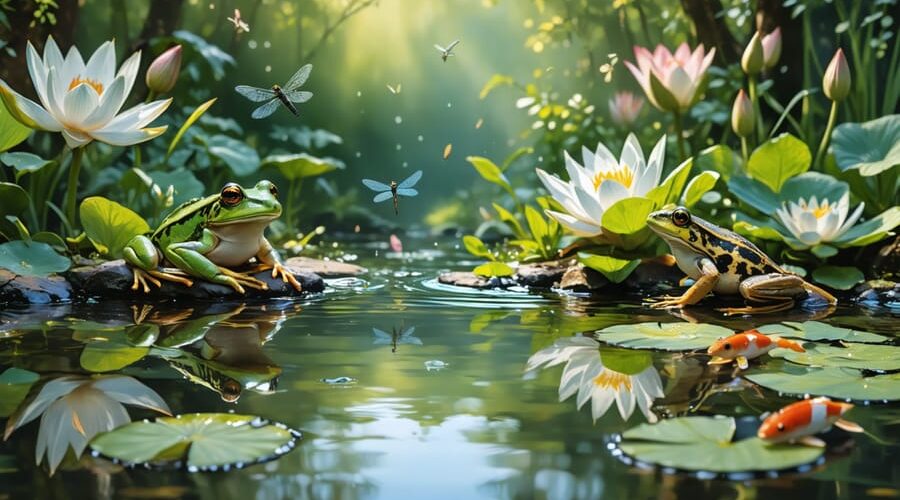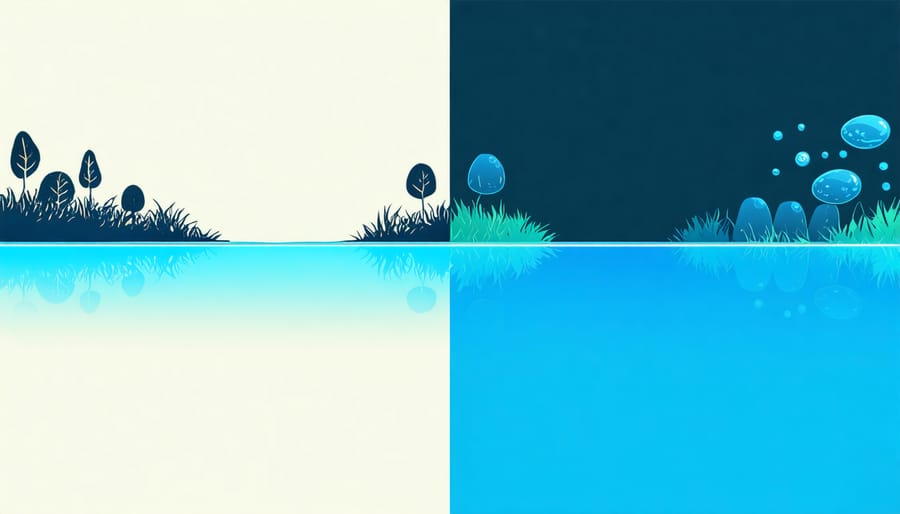
How Your Pond Activities Affect Local Wildlife (And What You Can Do About It)
Ponds pulse with life, creating miniature ecosystems that showcase the diverse wildlife of pond habitats. From darting dragonflies skimming the water’s surface to vocal frogs announcing the arrival of spring, these aquatic havens support an intricate web of creatures that bring both beauty and ecological balance to our backyards. Every ripple and splash tells the story of countless species – including amphibians, insects, birds, and even small mammals – that depend on these vital water sources for survival. Understanding how our pond management choices impact these delicate ecosystems empowers us to create thriving sanctuaries where wildlife can flourish alongside our gardening goals. Whether you’re maintaining an existing pond or planning to build one, learning to balance human activity with wildlife needs ensures these magical water features remain vibrant centers of biodiversity for years to come.
Common Pond Wildlife You’ll Encounter

Aquatic Residents
Ponds are teeming with life beneath the surface, hosting a diverse community of aquatic residents that contribute to a healthy pond ecosystem balance. Fish are often the most visible inhabitants, with popular species like goldfish and koi adding vibrant colors and movement to your water feature. These swimming friends not only provide visual interest but also help control mosquito larvae and other small insects.
Amphibians are another crucial group of pond dwellers. Frogs and toads use ponds as breeding grounds, laying their eggs in spring. Their tadpoles are fascinating to watch as they develop, and adult amphibians help keep garden pests in check. You might hear their distinctive calls during evening hours, adding a natural soundtrack to your outdoor space.
The smallest, yet equally important residents are aquatic insects. Dragonfly and damselfly nymphs patrol beneath the surface, while water striders skate gracefully across it. Water beetles and diving bugs create constant activity, and even mosquito larvae serve as food for other creatures. These insects form the foundation of your pond’s food web.
Some less obvious residents include freshwater snails and small crustaceans, which help keep your pond clean by consuming algae and decomposing plant matter. Together, these aquatic residents create a mini-ecosystem right in your backyard, each playing their part in maintaining the water’s health and vitality.
Visiting Wildlife
Ponds attract a fascinating variety of visiting wildlife throughout the year. Birds are among the most frequent visitors, with species like herons, kingfishers, and ducks dropping by for a drink or to hunt for fish. Even smaller garden birds like robins and sparrows will visit to bathe and drink, especially during hot summer days.
Mammals also make regular appearances at pond edges. Hedgehogs often come to drink and hunt for insects, while foxes and deer might stop by for refreshment. In rural areas, you might spot raccoons or opossums visiting at dusk or dawn. These mammals not only use ponds as water sources but also feed on the insects and small creatures living around the water’s edge.
Reptiles and amphibians frequently visit ponds, with many using them as breeding grounds. Turtles may bask on logs or rocks placed near the water, while snakes might hunt for frogs or small fish. During breeding season, you’ll likely notice an increase in frog and toad activity as they return to water to lay their eggs.
To encourage these wonderful visitors, consider creating gentle slopes at the pond’s edge for easy access and adding natural features like logs or rock piles nearby for shelter. Remember that visiting wildlife is most active during dawn and dusk, so these are the best times for quiet observation. Keep pets away during these peak visiting hours to avoid disturbing your wild guests.
How Your Pond Maintenance Affects Wildlife
Chemical Treatments and Wildlife Health
Chemical treatments in ponds, while sometimes necessary for maintenance, can significantly impact wildlife health. Algaecides and other chemical solutions need to be used thoughtfully to protect the delicate balance of your pond’s ecosystem.
When using algaecides, opt for copper-free varieties whenever possible, as copper-based products can be harmful to fish, amphibians, and beneficial insects. If you must treat algae, consider applying treatments in sections rather than treating the entire pond at once, giving wildlife a chance to move to safer areas.
pH adjusters should be used sparingly and gradually. Sudden changes in water chemistry can stress fish and other aquatic creatures. Natural solutions like adding limestone rocks or using barley straw can help maintain healthy pH levels without harsh chemicals.
Many pond owners don’t realize that even seemingly harmless treatments can affect the food chain. For instance, treatments that kill mosquito larvae might also harm dragonfly nymphs and other beneficial insects that help control pest populations naturally.
Before using any chemical treatment, consider these wildlife-friendly alternatives:
– Manual removal of excess vegetation
– Installing aerators to improve water quality
– Using beneficial bacteria to break down organic matter
– Creating natural filtration with aquatic plants
If chemical treatments are necessary, always follow dosage instructions carefully and monitor wildlife behavior afterward. Remember, a healthy pond ecosystem often requires minimal chemical intervention.

Physical Maintenance Activities
Regular pond maintenance is essential for a healthy ecosystem, but it’s important to consider how these activities affect wildlife. When cleaning your pond, work in sections rather than disturbing the entire habitat at once. This allows creatures to relocate temporarily to undisturbed areas.
Pruning aquatic plants should be done gradually throughout the growing season. Removing too much vegetation at once can disturb nesting sites and remove valuable cover that small creatures use for protection. Leave some dead plant material during fall cleanup, as many insects and amphibians use it for winter shelter.
Water level changes can significantly impact pond wildlife. Sudden drops can strand fish in shallow areas or expose amphibian eggs. If you need to lower the water level for maintenance, do it slowly over several days. During summer, maintain consistent water levels to protect tadpoles and aquatic insects developing near the shoreline.
When removing debris, carefully check for small creatures that might be hiding in plant matter or fallen leaves. Create temporary holding areas with pond water to house any animals you find during cleaning. Always return them to the pond once you’ve finished maintaining that section.
Remember that some algae and organic matter are natural parts of a healthy pond ecosystem. While keeping the pond tidy is important, avoid over-cleaning, which can remove valuable microhabitats that support your pond’s wildlife community.
Feeding and Stock Management
Proper feeding and population management in your pond directly impacts the wildlife ecosystem. While it’s tempting to toss bread to visiting ducks or overstock with colorful fish, these actions can create problems for your pond’s natural balance.
When feeding fish, stick to appropriate pond food and limit quantities to what they can consume within 5 minutes. Excess food decomposes, reducing water quality and potentially harming amphibians and insects that call your pond home. Consider using floating feeding rings to contain food and make cleanup easier.
Population control is equally crucial. Overstocking fish can lead to excessive waste, reduced oxygen levels, and increased competition for resources. A good rule of thumb is one inch of fish per square foot of surface area. This allows enough space for native wildlife like frogs, newts, and beneficial insects to thrive alongside your fish.
Natural predators like herons and kingfishers help maintain fish populations, though they might seem like unwelcome visitors. Rather than deterring them completely, consider creating deeper areas or shelter zones where fish can hide while still allowing these beautiful birds to be part of your pond’s ecosystem.
During spring and summer, monitor fish breeding activity. If necessary, separate young fish or consider rehoming some to maintain healthy population levels. This ensures your pond remains a balanced habitat for all wildlife residents.
Wildlife-Friendly Pond Management
Natural Alternatives to Chemicals
Maintaining a healthy pond doesn’t always require harsh chemicals. There are several natural alternatives for pond maintenance that are both effective and wildlife-friendly. Barley straw is a fantastic natural algae inhibitor – simply place it in mesh bags around your pond’s edge. As it decomposes, it releases compounds that naturally discourage algae growth without harming other aquatic life.
Adding beneficial bacteria helps break down organic matter naturally, reducing the need for chemical cleaners. These microscopic helpers work tirelessly to maintain water quality while supporting your pond’s ecosystem. Native aquatic plants are nature’s own filtering system – water lilies, rushes, and hornwort not only look beautiful but also compete with algae for nutrients.
For pest control, consider introducing natural predators like dragonfly nymphs, which feed on mosquito larvae. Creating shallow areas with pebbles attracts birds that help control insects naturally. A UV clarifier can keep water clear without chemicals, while adding oxygen-producing plants helps maintain healthy water conditions.
Remember to remove fallen leaves regularly and maintain proper water circulation – these simple actions reduce the need for chemical interventions. By working with nature rather than against it, you’ll create a thriving ecosystem that largely maintains itself.
Creating Wildlife Havens
Creating a wildlife-friendly pond is easier than you might think! Start by incorporating different water depths – shallow margins for amphibians to enter and exit, and deeper areas (at least 2 feet) for fish and hibernating frogs. Add native aquatic plants like water lilies and marsh marigolds, which provide natural shelter and breeding spaces.
Consider creating gentle slopes rather than steep edges, making it easier for animals to access the water. Install partially submerged logs or rocks near the edges to create basking spots for frogs and dragonflies. Leave some leaf litter at the bottom of your pond – it provides valuable habitat for invertebrates and hiding places for tadpoles.
Plant a variety of marginal plants around the pond’s edge to attract insects and provide cover for small animals. Native grasses, sedges, and flowering plants like purple loosestrife or yellow flag iris are excellent choices. Avoid cutting back all vegetation during autumn – leave some standing plants for winter shelter.
Keep a wild area near your pond with long grass, log piles, or stone piles. These create essential corridors for wildlife moving between water and land. Consider adding a shallow beach area using pebbles or gravel, which becomes a valuable drinking spot for birds and insects.
Remember to maintain good water quality by avoiding chemical treatments and keeping fallen leaves under control. A healthy, balanced pond naturally attracts and sustains diverse wildlife throughout the year.

Seasonal Considerations
Understanding seasonal wildlife patterns is crucial when planning pond maintenance activities. Different creatures have varying needs throughout the year, and timing your maintenance correctly can help protect and support your pond’s wildlife.
Spring is a particularly sensitive time as amphibians return to breed and lay eggs. Try to complete major cleaning tasks before March to avoid disturbing breeding frogs and newts. If you need to remove pond plants during this period, check carefully for egg masses attached to vegetation.
Summer maintenance should be minimal, as this is when your pond is teeming with life. If you must trim plants or clean filters, do so gradually and inspect removed material for creatures that need returning to the water. Many insects and tadpoles use underwater plants as shelter during this time.
Autumn is ideal for larger maintenance tasks, as most breeding cycles are complete. However, be mindful of hibernating amphibians when removing fallen leaves. Leave some natural debris for winter shelter.
Winter requires a gentler approach. Avoid breaking ice on the pond surface, as this can disturb hibernating wildlife. Instead, use a floating ball or de-icer to maintain a small opening for gas exchange. If you need to clean the pond during winter, work slowly and carefully to avoid disturbing any creatures in their winter rest.
As we’ve explored throughout this article, ponds are incredible ecosystems teeming with diverse wildlife, from playful amphibians to delicate dragonflies. Each creature plays a vital role in maintaining the natural balance of your pond, creating a thriving miniature world in your backyard.
Remember that successful pond management isn’t just about maintaining water quality or controlling plant growth – it’s about creating and preserving a sanctuary where wildlife can flourish. By implementing wildlife-friendly practices like maintaining varying water depths, incorporating native plants, and avoiding harsh chemicals, you’re not only enhancing your pond’s beauty but also supporting local biodiversity.
The key to responsible pond management lies in finding the right balance between human enjoyment and wildlife preservation. Small actions, like leaving fallen leaves for hibernating creatures or creating shallow areas for amphibians, can make a huge difference to your pond’s wildlife population.
As you continue caring for your pond, observe the changes throughout the seasons and celebrate the new creatures that make your water garden their home. Whether you’re a seasoned pond keeper or just starting out, your efforts in maintaining a wildlife-friendly pond contribute to the broader conservation of these precious aquatic ecosystems.
Together, we can ensure our ponds remain vibrant habitats for future generations of wildlife to enjoy. Keep learning, stay curious, and most importantly, cherish the wonderful wildlife that brings your pond to life.
